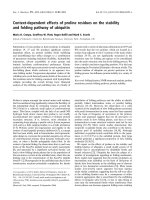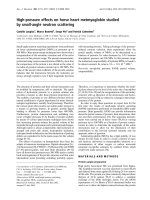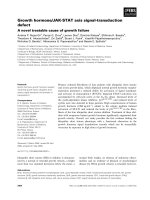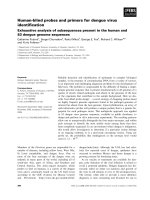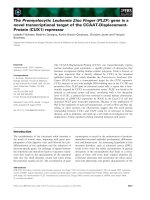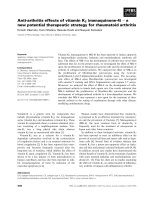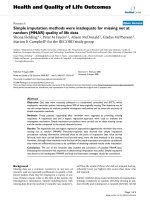Báo cáo khoa học: "Consequential late effects after radiotherapy for prostate cancer - a prospective longitudinal quality of life study" pps
Bạn đang xem bản rút gọn của tài liệu. Xem và tải ngay bản đầy đủ của tài liệu tại đây (298.94 KB, 9 trang )
RESEARC H Open Access
Consequential late effects after radiotherapy
for prostate cancer - a prospective longitudinal
quality of life study
Michael Pinkawa
*
, Richard Holy, Marc D Piroth, Karin Fischedick, Sandra Schaar, Dalma Székely-Orbán,
Michael J Eble
Abstract
Background: To answer the question if and to which extent acute symptoms at the end and/or several weeks
after radiotherapy can predict adverse urinary and gastrointestinal long-term quality of life (QoL).
Methods: A group of 298 patients has been surveyed prospectively before (time A), at the last day (B), two
months after (C) and >one year after (D) radiotherapy using a validated questionnaire (Expanded Prostate Cancer
Index Composite). A subgroup of 10% with the greatest urinary/bowel bother score decrease at time D was
defined as patients with adverse long-term QoL.
Results: Subgroup and correlation analyses could demonstrate a strong dependence of urinary/bowel QoL after
radiotherapy on urinary/bowel QoL before radiotherapy. In contrast to absolute scores, QoL score changes (relative
to baseline scores) did not correlate with pretreatment scores. Long-term changes could be well predicted by
acute changes. Patients reporting great/moderate bother with urinary/bowel problems at time C reported to have
great/moderate bother at time D in ≥ 50%, respectively. In a multivariate analysis of factors for adverse long-term
urinary and bowel QoL, score changes at time C were found to be independent predictors, respectively.
Additionally, QoL changes at time B were independently predictive for adverse long-term bowel QoL.
Conclusions: Consequential late effects play a major role after radiotherapy for prostate cancer. Patients with
greater and particularly longer non-healing acute toxicity are candidates for closer follow-up and possible
prophylactic actions to reduce a high probability of long-term problems.
Background
External beam radiotherapy is a well established curative
treatment for localized prostate cancer [1]. Acute and
late toxicity rates after radiotherapy can be considerable
and have been subject of many studies. Dose-volume
effect relationships have been described extensively
[2-6]. Dose escalation studies support the benefit of a
dose escalation to total doses approaching 80 Gy con-
cerning the biochemical tumour control or disease-spe-
cific survival [7-9]. Subgroups of patients - especially
patients with low initial PSA levels <10 ng/ml [8] or <15
ng/ml [7] or low-risk patients [ 9] - have not been con-
vincingly shown to benefit from total doses >70 Gy.
Dose escalation was also associated with a significant
increase in late gastrointestinal toxicity [9,10].
In the early years of radiotherapy, the “skin erythema
dose” was used for the definition of tolerable doses.
During subsequent years, it was realized that no rela-
tionship between acute reactions to radiation exposure
and late sequelae in other organs and tissues could be
established in the majority of patients. More aggressive
radiotherapy protocols can result in aggravation, i.e. an
increase in severity and duration, of acute ra diation
effects. Particularly in those organ systems in which a
barrier against mechanical and/or chemical stress is
established by the acutely responding component - a
non-healing acute response can directly progress into a
late effect. This phenomenon has been termed a conse-
quential late effect [11].
* Correspondence:
Department of Radiation Oncology, RWTH Aachen University, Pauwelsstrasse
30, 52072 Aachen, Germany
Pinkawa et al. Radiation Oncology 2010, 5:27
/>© 2010 Pinkawa et al; licensee BioMed Central Ltd. This is an Open Access article distributed under the terms of the Creative Commons
Attribution License (http://creativecommo ns.org/li censes/by/2.0), which permits unrestricted use, distribution, and reproduction in
any medium, provide d the original work is properly cited.
Consequential late effects have also been reported for
prostate cancer patients [12,13]. However, though qual-
ity of life (QoL) issues are increasingly addressed in the
literature [14-17], the impact of acute on late QoL
changes has not been analyzed before.
The aim of this study was to answer the question if
and to which extent acute symptoms at the end and/or
several weeks after radiotherapy can predict adverse
urinary and gastrointestinal long-term quality of life
(QoL). Patients responded to a QoL questionnaire
before, at t he last day, two m onths (median time) after
and more than one year after treatment. QoL score
changes in the urinary and bowel domain relati ve to the
baseline scores before treatments indicated the extent of
QoL impairment.
Methods
This study was based on consecutive patients who were
treated due to localized T1-3N0M0 prostatic carcinoma
with three-dimensional conformal radiotherapy in the
year s 2003-2007. Treatment plans were calculated using
a four-field box technique with 15 MeV photons and a
multileaf collimator, as reported recently in detail [17].
A margin of 1.5 cm in the anterior/lateral and 1 cm in
the craniocaudal and dorsal directions to the CTV
(prostate with or without seminal vesicles) was applied
to define the PTV. The total dose to the prostate in the
reference point was 70.2 or 72 Gy at 1.8 or 2.0 Gy
daily fractions. The integral dose (AUC-ar ea under the
curve) was defined as the relation of t he area under the
dose-volume histogram curve to the total area, multi-
plied by 100.
An initial group of 324 patients has been surveyed
prospectively before (time A), a t the last day (B), two
months (median, range 6 weeks-6 months, 71% within 9
weeks) after (C) and sixteen months (median, range 12-
20 months) after (D) radiotherapy using a validated
questionnaire, the E xpanded Prostate Cancer Index
Composite (EPIC) [18,19]. The questionnaire comprises
50 items concerning the uri nary, bowel, sexual and hor-
monal domains for function and bothersomeness. Only
patients with questionnaire results from both time A
and time D have been included in the analysis (92% of
the initial group), resulting in 298 (A), 213 (B), 267 (C)
and 298 (D) questionnaires at the respective points in
time. The multi-item scale scores were transformed line-
ary to a 0-100 scale, with higher scores representing bet-
ter health-related quality of life (QoL). In accordance
with data in the literature, mean QoL changes of below
5 points can be defined as clinically not significant, 5-10
as “little” changes, 10-20 as “moderate” changes and >20
as “very much” changes [20,21].
The questionnaire was handed over to the patients
personally by one of the physicians at time A, B and C.
Patients presented in the department six to ten weeks
after the end of treatment. Missed questionnaires in the
acute phase (time C) and questionnaires one to two
years after radiotherapy (time D) were sent to the
patients with a return envelope. If a questionnaire was
not returned within four weeks, patients were contacted
by telephone and urged to complete it.
Those 10% of patients who repor ted the greatest
adverse changes of ur inary or bowel bother scores
(implicating 7 items, respectively) at time D were in a
particular focus of this study. They were defined as
patients with adverse long-term urinary or bowel QoL.
To evaluate the impact of pretreatment scores on post-
treatment scores, patients were divided into quartiles in
dependence on their pretreatment urinary or bowel
bother scores. Patients with the best pretreatment QoL
were subsumed in an upper quartile (those 25% of
patients with the hig hest scores), patients with the worst
pretreatment QoL in a lower quartile (those 25% of
patients with the highest scores), remaining patients in
the medial quarters.
Sexual and hormonal domains were not considered in
this evaluation. As previously demonstrated, sexual
function does usually not recover after a decline in the
acute phase [22], whereas the hormonal domain cannot
be regarded as a domain with major effects from the
local radiotherapy treatment.
Statistical analysis was performed using the SPSS 17.0
(SPSS, Chicago, Ill), software. The Wilcoxon’s matched-
pairs test was applied to determine longitudinal changes
in specific subgroups of patients. To explore statistical
QoL score differences between different subgroups at a
specific time, the Mann-Whitney-U -test was used. Con-
tingency table analysis with the chi-square test was per-
formed to compare treatment groups with respect to
categorical variables. To a ssess the correlation between
different scores or score changes, Spearman’ srhowas
determined (correlation coefficient >0.4 considered as a
relevant correlation). In a forward stepwise univariate
and multivariate analysis, pretreatment scores and score
changes were tested for their impact on adverse long-
term urinary or bowel Q oL. All p-values reported are
two-sided, p < 0.05 is considered significant.
Results
The median patient age was 71 (45-84) years. Patients
could be classified as low risk (PSA ≤ 10 ng/ml; Gleason
score <7; cl inic al T-stage ≤ 2a) , intermediate risk (PSA
10-20 ng/ml or Gleason s core = 7 or clinical T-stage
2b-c) and high risk (two risk factors for intermediate
risk or PSA > 20 ng/ml or Gleason score >7 or clinical
T-stage >2c) patients in 37%, 35% and 28%, respectively.
Focusing on the dependence of posttreatment scores
from pretreatment scores, a different course of urinary
Pinkawa et al. Radiation Oncology 2010, 5:27
/>Page 2 of 9
and bowel bother scores could b e clearly demonstrated
(Figure 1 ). Patients with the worst - medial - best pre-
treatment urinary bother scores improved - remained
stable - worsened significantly at times C and D. Scores
at time C were nearly identical as the scores at time D.
In the bowel domain, the scores improved significantly
between times B and C in every subgroup, comparably
to the urinary domain. A further improvement between
times C and D was noticed in the subgroups with med-
ial and best pretreatment bow el bother scores. Relative
to baseline levels, mean scores of all subgroups
decreased at time D in the range of 6-7 points.
Treatment-related character istics (fraction dose, total
dose, prostate volume, PTV, AUC for bladder and rec-
tum, organ volumes within any of the iso doses 10-100%,
percentage of patients with neoadjuvant hormonal ther-
apy) did not differ significantly for the patients who
were selected as pat ients with adverse long-term urinary
or bowel QoL in comparison to other patients (Table 1).
Looking at the prior scores of these patients, only small
differences could be seen before treatment (Figure 2).
Urinary bother scores were diverging clearly at time C,
in contrast to a divergence of bowel bother scores
already at time B.
Figure 1 Mean urinary (A) and bowel (B) bother scores in dependence on the baseline scores. A: Baseline score for lower quarter: <70;
medial quarter: 70-95; upper quarter: >95. All changes statistically significant (p < 0.05), except changes at time D for patients in the medial
quarter. B: Baseline score for lower quarter: <93; medial quarter: 93-99; upper quarter: 100. All changes statistically significant (p < 0.05).
Pinkawa et al. Radiation Oncology 2010, 5:27
/>Page 3 of 9
Focusing on great/moderate bother from particular
problems (specific items of the questionnaire), we found
a missing dependence from pretreatment symptoms,
and the strongest dependence from symptoms several
weeks after radiotherapy (Table 2). Patients reporting
great/moderate bother with urinary/bowel problems at
time C reported to h ave great/moderate bother at time
Din≥ 50%, respectively. Only ≤ 7% of patients without
great/moderate bother with urinary/bowel problems
at time C reported to have great/moderate bother at
time D.
Defining bother score decreases >20 points as severe
changes, patients with vs. without severe urinary QoL
changes at times B and C were found to also have
severe urinary QoL changes at time D in 14% vs. 6%
(p = 0.042) and 40% vs. 7% (p < 0.001). Patients with vs.
without severe bowel QoL changes at times B and
C were found to also have severe bowel QoL changes
at time D in 30% vs. 7% (p < 0.001) and 49% vs. 7%
(p < 0.001).
Correlating absolute urinary and bowel scores at dif-
ferent intervals, good intra- and interdomain correla-
tions of urinary and bowel scores became evident - with
higher correlation indices after than before radiotherapy.
A strong correlation between scores at different intervals
within a specific domain resulted (Table 3). Considering
pretreatment urinary/bowel QoL scores and QoL score
changes relative to baseline scores at times B, C and D,
the h ighest correlation coefficients were found between
changes at times C and D (r > 0.5; p < 0.001), respec-
tively (Table 4, pretreatment scores not shown due to
low correlation coefficients r < 0.4).
In a univariate analysis of factors for adverse long-
term urinary and bowel QoL (Table 5 ), various f actors
were found to significantly predict adverse long-term
QoL - including crossover relations between the urinary
and bowel domains. Patients with adverse long-term
urinary QoL were more likely to have adverse long-term
bowel QoL and vice versa (patients with vs. without
adverse urinary QoL reported a mean bowel score
decrease of 21 vs. 5 points at time D; p < 0.001; patients
with vs. without adverse bowel QoL reported a
mean urinary score decrease of 16 vs. -1 points at time
D; p < 0.001).
The multivariate analysis was performed to demon-
strate independent factors - intradomain score changes
relative to baseline at time C proved to be independent
significant predictors for adverse score changes at time
D, respectively. Additionally, bowel QoL changes at time
B were independently predictive for a dverse long-term
bowel QoL (Table 5).
Discussion
In this study, we could demonstrate the strong influence
of acute side effects on long-term toxicity in prostate
cancer treatment. In contrast to studies in the past,
based on a grading system [ 12,13], a quality of life ana-
lysis was used to elaborate the impact of consequential
Table 1 Demographic and treatment-related characteristics of patients with vs. without adverse long-term quality of
life (QoL) scores
adverse long-term urinary QoL adverse long-term bowel QoL
yes (n = 261) no (n = 35) yes (n = 264) no (n = 32)
patient age/years
median (range)
72 (51-83) 71 (45-84) 71 (51-82) 72 (45-84)
% fraction dose 1.8 Gy 69% 72% 72% 72%
% total dose 72 Gy 54% 56% 59% 55%
prostate volume/cc
median (range)
40 (18-107) 39 (11-151) 36 (14-107) 40 (11-151)
% NHT 34% 32% 38% 32%
PTV/cc
median (range)
338 (212-529) 330 (169-631) 339 (117-517) 330 (177-517)
bladder volume/cc
median (range)
220 (54-657) 192 (14-806) 181 (82-657) 194 (14-806)
rectum volume/cc
median (range)
102 (43-295) 97 (28-401) 93 (38-295) 98 (28-401)
AUC for bladder/%
median (range)
37 (12-69) 41 (7-98) 35 (7-78) 41 (7-98)
bladder volume within 90% isodose*/% 20 (5-46) 21 (2-64) 20 (3-54) 22 (2-57)
AUC for rectum/%
median (range)
52 (33-77) 51 (19-84) 47 (23-70) 52 (19-84)
rectum volume within 90% isodose*/% 27 (6-64) 28 (6-60) 24 (12-50) 28 (6-64)
*100% = prescription dose of 70.2-72 Gy; 90% = 63.2-64.8 Gy
Pinkawa et al. Radiation Oncology 2010, 5:27
/>Page 4 of 9
late effects on long-term quality of life. EPIC question-
naire measurements have the advantage of being more
sensitive to chan ges in acute bowel toxicity in compari-
son to RTOG acute morbidity scoring criteria or procto-
scopic toxicity scores [23]. Apparently, prostate cancer
radiotherapy with doses >70 Gy can lead to a relevant
severity and duration of acute radiation effects. The
intestinal or bladder mucosa is damaged to a consider-
able degree, so that an adequate barrier against mechan-
ical and/or chemical stress is not present any more for a
considerable period of time. The non-healing response
can progress directly into a late effect. In contrast to a
low percentage of patients (5-7%) who assess their urin-
ary function or bowel habits to be a great or moderate
problem more than a year after radiotherapy without
the same assessment already several weeks after radio-
therapy, ≥ 50% who reported one of these problems sev-
eral weeks after radiotherapy still had the same bother
more than a year after radiotherapy, respectively.
Urinary and bowel QoL after radiotherapy was found to
be strongl y dependent on urinary and bowel QoL befor e
radiotherapy. Nevertheless, a difference was found
between urinary and bowel QoL. Acute bowel problems
were gradually improving over time. In comparison to
baseline, scores at time D decreased 6-7 points for all sub-
groups. In contrast to bowel bother scores, no further
improvement was noticed for urinary bother scores
between time C and D. Significantly lower scores at times
Figure 2 Mean urinary (A) and bowel (B) bother scores for patients with vs. without adverse long-term urinary quality of life (QoL).
Pinkawa et al. Radiation Oncology 2010, 5:27
/>Page 5 of 9
C and D in comparison to baseline were only found for
the patients with the best baseline scores. Urinary QoL for
the patients with initially very low scores improved signifi-
cantly, suggesting a possible effect of radiotherapy on the
reduction of benign prostatic hyperplasia. Long-term urin-
ary and bowel scores at time D were correlating well with
the respective scores at time A - but also B and C. Corre-
lation indices were gradually improving over time, so that
the best correlation was found between the respective
scores at times C and D (Table 3).
A different aspect (main aspect) of this study is the
evaluation of QoL score changes relative to baseline
Table 2 Percentage of patients reporting certain long-term bother (time D) in dependence on pretreatment (time A)
or acute (time B and C) bother
probability of long-term bother at time D
if bother already present vs. absent at time A/B/C [p-value]
great/moderate bother with: time A time B time C
dripping or leaking urine 6% vs. 8%
n.s.
19% vs. 3%
[0.001]
50% vs. 3%
[<0.001]
pain or burning on urination 0% vs. 6%
n.s.
11% vs. 1%
[0.001]
28% vs. 3%
[<0.001]
waking up to urinate 26% vs. 29%
n.s.
44% vs. 8%
[<0.001]
72% vs. 13%
[<0.001]
urinary function overall 7% vs. 16%
n.s.
24% vs. 5%
[<0.001]
50% vs. 7%
[<0.001]
urgency to have a bowel movement 21% vs. 13%
n.s.
25% vs. 5%
[<0.001]
50% vs. 6%
[<0.001]
losing control of stools 25% vs. 5%
n.s.
25% vs. 1%
[<0.001]
45% vs. 3%
[<0.001]
bloody stools - vs. 3%* 0% vs. 3%
n.s.
33% vs. 2%
[<0.001]
bowel habits overall 28% vs. 13%
n.s.
34% vs. 3%
[<0.001]
56% vs. 5%
[<0.001]
Example: 56% of patients with great/moderate bother with bowel habits overall at time C report the same bo ther at time D; 5% of patients without great/
moderate bother with bowel habits overall at time C report this bother at time D
n.s. = not significant
*no patients with great/moderate bother with bloody stools at time A
Table 3 Spearman’s correlation index between quality of life scores (only indices r > 0.4 shown; p < 0.001 for all)
UBS time A BBS time A UBS time B BBS time B UBS time C BBS time C UBS time D BBS time D
UBS time A 0.43 0.54 - 0.56 - 0.55 -
BBS time A 0.43 - - - - - 0.48
UBS time B 0.54 - 0.54 0.64 - 0.56 -
BBS time B - - 0.54 0.42 0.63 0.41 0.50
UBS time C 0.56 - 0.64 0.42 0.53 0.69 -
BBS time C - - - 0.63 0.53 0.46 0.57
UBS time D 0.55 - 0.56 0.41 0.69 0.46 0.54
BBS time D - 0.48 - 0.50 - 0.57 0.54
Abbreviations: UBS = urinary bother score; BBS = bowel bother score
Table 4 Spearman’s correlation index between quality of life score changes relative to baseline scores at time A
(only indices r > 0.4 shown; p < 0.001 for all)
UBS change
time B
BBS change time B UBS change time C BBS change time C UBS change time D BBS change time D
UBS change time B 0.45 0.51 - - -
BBS change time B 0.45 - 0.53 - -
UBS change time C 0.51 - - 0.55 -
BBS change time C - 0.53 - - 0.52
Abbreviations: UBS = urinary bother score; BBS = bowel bother score
Pinkawa et al. Radiation Oncology 2010, 5:27
/>Page 6 of 9
scores before treatment. In cont rast to an absolute QoL
level, adverse changes imply radiotherapy toxi city -
impossible to assess with a single measurement after
radiotherapy. In contrast to absolute scores, QoL score
changes were not correlating with pretreatment scores.
In respect of long-term scores, the best predictive value
(greatest correlation index) was found for scores at time
C, i.e. in case of considerable acute changes several
weeks after treatment, comparable changes can still be
expected more than one year after treatment.
Finally, we have focused on the patients with the great-
est long-term QoL impairment relative to baseline scores.
We could exclude a significant impact of treatment-
related characteristics on this impairment for this parti-
cular patient group - not implying that these characteris-
tics do not have any meaning for radiotherapy-related
toxicity. As reported in the already published studies, fac-
tors like bladder volume, prostate volume or hormonal
therapy have certainly an influence on particular pro-
blems [4,21]. A particular aspect of this evaluation is a
homogenous treatment of the total study group concern-
ing the technique, planning target volume definition and
dose prescription. In most other study populations,
patients with various techniques and total doses are com-
bined [1,3,12,13,24]. The significant impact of dose to
critical structures on toxicity could be demonstrated in
these studies with different dose levels. This correlation
could not be shown in our homogenous study population
(all patients treated with the same technique to a dose of
70.2-72Gy).Wehavetobeawarethatthedose-volume
histogram is related to a single treatment planning CT
scan. Taking into account changing organ volumes dur-
ing the tr eatment [25,26], it might not be sensitive
enough to discriminate clearly between patients with
higher or lower volumes within certain dose levels over
the entire treatment (all individual fractions).
Considering QoL scores of patients with the greatest
long-term impairment in comparison to other patients
(Figure 2), differences of QoL scores became well evi-
dent with time. A considerable divergence of urinary
scores resulted at time C: patients with adverse long-
term QoL were not able to recover from their acute
symptoms - in contrast to a complete recovery for other
patients. The impact of consequential late effects is
demo nstrated clearly in these curves. Patients with con-
sequential late effects were not able to repair the acute
tissue damage and QoL decreased even more with time.
In contrast to the urinary domain, a drastic diverg ence
of bowel bother scores resulted already at time B. A
similar progression followed: patients with adverse long-
term QoL were not able to repair the damage, while
other patients (nearly) returned to their baseline levels
before radiotherapy. T he multivariate analysis supports
well the results of these curves: urinary bother score
changes at time C were highly predictive of adverse
long-term urinary QoL; bowel bother score changes at
times B and C were independently predictive for adverse
long-term bowel QoL.
Urinary and bowel score changes at time C hav e been
shown to predict both adverse urinary and bowel long-
term QoL in univariate analysis. The interdomain pre-
dictions were not independent from the respective other
Table 5 Predictive factors for low long-term quality of life (QoL) in univariate and multivariate analysis (urinary and
bowel bother scores at time A and score changes relative to baseline scores at times B and C were tested; significant
factors are presented)
univariate analysis multivariate analysis
item risk factor hazard ratio
[95% CI]
p-value hazard ratio
[95% CI]
p-value
low long-term urinary QoL urinary bother score at time B 1.03
[1.00-1.05]
0.032 - -
urinary bother score change at time C 1.06
[1.04-1.08]
<0.001 1.06
[1.04-1.08]
<0.001
bowel bother score at time A 1.03
[1.00-1.05]
0.028 - -
bowel bother score change at time C 1.03
[1.01-1.04]
0.002 - -
low long-term bowel QoL urinary bother score change at time B 1.02
[1.00-1.04]
0.048 - -
urinary bother score change at time C 1.02
[1.00-1.04]
0.031 - -
bowel bother score change at time B 1.05
[1.03-1.08]
<0.001 1.03
[1.00-1.06]
0.049
bowel bother score change at time C 1.06
[1.04-1.08]
<0.001 1.05
[1.02-1.08]
<0.001
Pinkawa et al. Radiation Oncology 2010, 5:27
/>Page 7 of 9
domain, i.e. they were not independent factors in the
multivariate analysis. An individual radiosensitivity is
suggested by these data: patients with reduced repair
capacity of the bladder wall or urethra are more likely
to have a reduce d repair capacity of the rectal wall and
vice versa.
The results of this study emphasize the need of close
follow-up and early prophylactic actions for patients with
greater and longer acute radiotherapy-associated toxici-
ties to possibly prevent late toxicities, though these possi-
bilities are curr ently limited. The time to filter candidates
for these actions can be two months after radiotherapy
(median time of time C questionnaire) concerning urin-
ary problems and the end of radiotherapy concerning
bowel problems. Taking into account the well known
association of dose with late toxicity [8,10], stopping the
radiation treatment at a lower dose (for example 70 Gy
instead of 80 Gy) might be advisable for selected patients
(for example older low-risk patients with limited life
expectancy and only questionable benefit of a dose esca-
lation) with heavy acute bowel toxicity. This concept is
currently not accepted. The decision for a dose prescrip-
tion is independent from the severity of acute effects.
There are no standard prophylactic regimens to ame-
liorate urinary symp toms after external beam radiother-
apy. After prostate brachytherapy - known to be
associated with greater urinary morbidity in comparison
to external beam radiotherapy - alpha-blockers are com-
monly administered. The beneficial effect on urinary
symptoms has been shown in a placebo-controlled ran-
domized study [27]. An advantage might also be possi-
ble for patients after external beam radiotherapy.
Patients with greater and longer acute rectal morbidity
should be advised to avoid unnecessary mechanical rec-
tal wall irritation - a low residue diet, reducing the fre-
quency and volume of stools might be beneficial in this
context. Constipation should be treated with adequate
dietary measures or laxatives.
Medical treatment with anti-inflammatory drugs, like
cort icost eroids or mesalamine, can reduce acute inflam-
matory symptoms. However, a long-term effect could
not be demonstrated in the past [28]. Anti-inflammatory
drugs are inhibiting protein synthesis, so that tissue
repair might even be impaired. Other drugs, like retinal
palmitate (vitamin A) might more effectively promote
wound healing [29]. P atients with acute bowel problems
should in any case be specifically informed to avoid
invasive procedures and biopsies of the rectal wall.
Biopsy may cause persistent inflammation, decrease
healing, and precipitate fistula formation [30].
Conclusions
In contrast to absolut e scores after radiotherapy, quality
of life changes cannot be predicted by pretreatment
scores. Consequential late effects play a major role after
radiotherapy for prostate cancer. Long-term gastroin-
testinal symptoms are well predicted by symptoms at
the end of and several weeks after treatment, suggesting
an inefficiency of the repair syste m and a non-healing
acute response. Urinary symptoms without recovery
within a few weeks after radiotherapy are likewise highly
predictive for adverse long-term urinary quality of life.
Patients with greater and longer acute toxicity are can-
didates for closer follow-up and possible prophylactic
actions to reduce a high probability of long-term pro-
blems, including possibly a total dose reduction for
selected patients with particularly bothersome acute gas-
trointestinal problems.
Acknowledgements
The study was funded by the research resources of the Department of
Radiation Oncology, RWTH Aachen University, Germany. We would like to
thank the staff who took care of our patients’ needs, and who were
involved in gathering, documenting, verifying, forwarding, and processing
the clinical data.
Authors’ contributions
MP, MJE have made substantial contributions to conception and design; MP
and KF have made substantial contributions to acquisition of data; MP, RH,
MDP, KF, SS, DS, MJE to analysis and interpretation of data. MP has been
involved in drafting the manuscript. RH, MDP, KF, SS, DS, MJE revised it
critically for important intellectual content. All authors have given final
approval of the version to be published.
Competing interests
The authors declare that they have no competing interests.
Received: 25 January 2010 Accepted: 8 April 2010
Published: 8 April 2010
References
1. Welz S, Nyazi M, Belka C, Ganswindt U: Surgery vs. radiotherapy in
localized prostate cancer. Radiat Oncol 2008, 3:23.
2. Cheung R, Tucker SL, Ye JS, Dong L, Liu H, Huang E, Mohan R, Kuban D:
Characterization of rectal normal tissue complication probability after
high-dose external beam radiotherapy for prostate cancer. Int J Radiat
Oncol Biol Phys 2004, 58:1513-1519.
3. Zapatero A, Garcia-Vicente F, Modolell I, Alcantara P, Floriano A, Cruz-
Conde A, Torres JJ, Pérez-Torrubia A: Impact of mean rectal dose on late
rectal bleeding after conformal radiotherapy for prostate cancer: dose-
volume effect. Int J Radiat Oncol Biol Phys 2004, 59:1343-1351.
4. Selek U, Cheung R, Lii M, Allen P, Steadham RE, Vantreese TR Jr, Little DJ,
Rosen II, Kuban D: Erectile dysfunction and radiation dose to penile base
structures: a lack of correlation. Int J Radiat Oncol Biol Phys 2004,
59:1039-1046.
5. Pinkawa M, Fischedick K, Asadpour B, Gagel B, Piroth MD, Eble MJ: Low-
grade toxicity after conformal radiation therapy for prostate cancer -
impact of bladder volume. Int J Radiat Oncol Biol Phys 2006, 64:835-841.
6. Michalski JM, Gay H, Jackson A, Tucker SL, Deasy JO: Radiation dose-
volume effects in radiation-induced rectal injury. Int J Radiat Oncol Biol
Phys 2010, 76:S123-S129.
7. Beckendorf V, Guerif S, Le Prise E, Cosset J, Bougnoux A, Chauvet B,
Salem N, Romenstaing P, Luporsi I, Bey P: 70 Gy versus 80 Gy dose
escalation getug 06 french trial for localized prostate cancer: mature
results. Int J Radiat Oncol Biol Phys 2008, 72:S96-S97.
8. Kuban DA, Tucker SL, Dong L, Starkschall G, Huang EH, Cheung MR, Lee AK,
Pollack A: Long-term results of the M.D. Anderson randomized dose-
escalation trial for prostate cancer. Int J Radiat Oncol Biol Phys 2008,
70:67-74.
Pinkawa et al. Radiation Oncology 2010, 5:27
/>Page 8 of 9
9. Peeters ST, Heemsbergen WD, Koper PC, van Putten WL, Slot A,
Dielwart MF, Dielwart MFH, Bonfer JMG, Incrocci L, Lebesque JV: Dose-
response in radiotherapy for localized prostate cancer: results of the
Dutch multicenter randomized phase III trial comparing 68 Gy of
radiotherapy with 78 Gy. J Clin Oncol 2006, 24:1990-1996.
10. Al-Mamgani A, van Putten WL, Heemsbergen WD, van Leenders GJLH,
Slot A, Dielwart MFH, Incrocci L, Lebesque JV: Update of dutch multicenter
dose-escalation trial of radiotherapy for localized prostate cancer. Int J
Radiat Oncol Biol Phys 2008, 72:980-988.
11. Dörr W, Hendry JH: Consequential late effects in normal tissues. Radiother
Oncol 2001, 61:223-231.
12. Schultheiss TE, Lee WR, Hunt MA, Hanlon AL, Peter RS, Hanks GE: Late GI
and GU complications in the treatment of prostate cancer. Int J Radiat
Oncol Biol Phys 1997, 37:3-11.
13. Heemsbergen WD, Peeters ST, Koper PC, Hoogeman MS, Lebesque JV:
Acute and late gastrointestinal toxicity after radiotherapy in prostate
cancer patients: consequential late damage. Int J Radiat Oncol Biol Phys
2006, 66:3-10.
14. Joseph KJ, Alvi R, Skarsgard D, Tonita J, Pervez N, Small C, Tai P: Analysis of
health-related quality of life (HRQoL) of patients with clinically localized
prostate cancer, one year after treatment with external beam
radiotherapy (EBRT) alone versus EBRT and high dose rate
brachytherapy (HDRBT). Radiat Oncol 2008, 3:20.
15. Fransson P, Lund J, Damber J, Klepp O, Wiklund F, Fossa S, Widmark A:
Quality of life in patients with locally advanced prostate cancer given
endocrine treatment with or without radiotherapy; 4-year follow-up of
SPCG-7/SFUO-3, an open-label, randomised, phase III trial. Lancet Oncol
2009, 10:370-380.
16. Geinitz H, Thamm R, Scholz C, Heinrich C, Prause N, Kerndl S, Keller M,
Busch R, Molls M, Zimmermann FB: Longitudinal analysis of quality of life
in patients receiving conformal radiation therapy for prostate cancer.
Strahlenther Onkol 2010, 186:46-52.
17. Pinkawa M, Piroth MD, Fischedick K, Nussen S, Klotz J, Holy R, Eble MJ: Self-
assessed toxicity after external beam radiotherapy for prostate cancer -
predictive factors on irritative symptoms, incontinence and rectal
bleeding. Radiat Oncol 2009, 4:36.
18. Wei JT, Dunn RL, Litwin MS, Sandler HM, Sanda MG: Development and
validation of the expanded prostate cancer index composite (epic) for
comprehensive assessment of health-related quality of life in men with
prostate cancer. Urology 2000, 56:899-905.
19. Volz-Sidiropoulou E, Pinkawa M, Fischedick K, Jakse G, Gauggel S, Eble MJ:
Factor analysis of the Expanded Prostate Cancer Index Composite (EPIC)
in a patient group after primary (external beam radiotherapy and
permanent iodine-125 brachytherapy) and postoperative radiotherapy
for prostate cancer. Curr Urol 2008, 2:122-129.
20. Ososba D, Rodrigues G, Myles J, Zee B, Pater J: Interpreting the
significance of changes in health-related quality-of-life scores. J Clin
Oncol 1998, 16:139-144.
21. Pinkawa M, Fischedick K, Asadpour B, Gagel B, Piroth MD, Nussen S,
Eble MJ: Toxicity profile with a large prostate volume after external
beam radiotherapy for localized prostate cancer. Int J Radiat Oncol Biol
Phys 2008, 70:83-89.
22. Pinkawa M, Gagel B, Piroth MD, Fischedick K, Asadpour B, Kehl M, Klotz J,
Eble MJ: Erectile dysfunction after external beam radiotherapy for
prostate cancer. Eur Urol 2009, 55:227-236.
23. Muanza TM, Albert PS, Smith S, Godette D, Crouse NS, Cooley-Zgela T,
Scinto L, Camphausen K, Coleman CN, Ménard C: Comparing measures of
acute bowel toxicity in patients with prostate cancer treated with
external beam radiation therapy. Int J Radiat Oncol Biol Phys 2005,
62:1316-1321.
24. Michalski JM, Winter K, Purdy JA, Parliament M, Wong H, Perez CA,
Roach M, Bosch W, Cox JD: Toxicity after three-dimensional radiotherapy
for prostate cancer on RTOG 9406 dose Level V. Int J Radiat Oncol Biol
Phys 2005, 62:706-713.
25. Martin JM, Bayley A, Bristow R, Chung P, Gospodarowicz M, Menard C,
Milosevic M, Rosewall T, Wade PR, Catton CN: Image guided dose
escalated prostate radiotherapy: still room to improve. Radiat Oncol 2008,
4:50.
26. Pinkawa M, Pursch-Lee M, Asadpour B, Gagel B, Piroth MD, Nussen S,
Eble MJ: Image-guided radiotherapy for prostate cancer. Implementation
of ultrasound-based prostate localization for the analysis of inter- and
intrafractiuon organ motion. Strahlenther Onkol 2008, 184:679-685.
27. Elshaikh MA, Ulchaker JC, Reddy CA, Angermeier KW, Klein EA, Chehade N,
Altman A, Ciezki JP: Prophylactic tamsulosin (Flomax) in patients
undergoing prostate 125I brachytherapy for prostate carcinoma: final
report of a double-blind placebo-controlled randomized study. Int J
Radiat Oncol Biol Phys 2005, 62:164-169.
28. Fantin AC, Binek J, Jabar FM, Meyenberger C: Argon beam coagulation for
treatment of symptomatic radiation-induced proctitis. Gastrointest Endosc
1999, 49:515-518.
29. Ehrenpreis ED, Jani A, Levitsky J, Ahn J, Hong J: A prospective,
randomized, double-blind, placebo-controlled trial of retinol-palmitate
(vitamin A) for symptomatic chronic radiation proctopathy. Dis Colon
Rectum 2005, 48:1-8.
30. Tran A, Wallner K, Merrick GS, Seeberger J, Armstrong J, Mueller A,
Cavanagh W, Lin D, Butler W: Rectal fistulas following prostate
brachytherapy. Int J Radiat Oncol Biol Phys 2005, 63:150-154.
doi:10.1186/1748-717X-5-27
Cite this article as: Pinkawa et al.: Consequential late effects after
radiotherapy for prostate cancer - a prospective longitudinal quality of
life study. Radiation Oncology 2010 5:27.
Submit your next manuscript to BioMed Central
and take full advantage of:
• Convenient online submission
• Thorough peer review
• No space constraints or color figure charges
• Immediate publication on acceptance
• Inclusion in PubMed, CAS, Scopus and Google Scholar
• Research which is freely available for redistribution
Submit your manuscript at
www.biomedcentral.com/submit
Pinkawa et al. Radiation Oncology 2010, 5:27
/>Page 9 of 9

